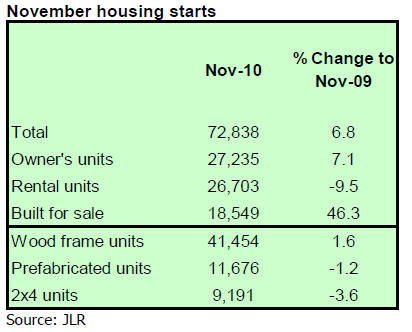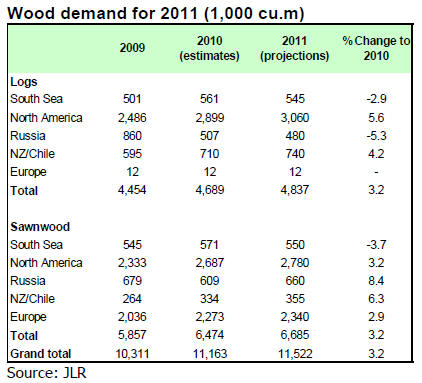Japan Wood Products
Prices
Dollar Exchange Rates of
04th Feb 2011
Japan Yen 82.20
Reports From Japan
Softening Yen pushes imported log prices higher
The market for tropical logs in Japan is firm, reports Japan
Lumber Reports (JLR). Prices of imported logs continue to
climb gradually as log suppliers remain bullish on prices
and the Yen eases marginally against the US dollar.
Plywood mills in Japan utilising imported tropical
hardwood logs are maintaining reduced production levels
at around 70% of full capacity. However, plywood
manufacturers’ log inventories are low and some mills
were trying to rebuild stocks ahead of the Chinese Lunar
New Year, but are facing difficulties in sourcing preferred
species and grades.
In Japan, CIF prices gained Yen 200 from December to
Yen 7,400-7,500 per koku for Sarawak meranti regular
logs. Small meranti logs are now priced at Yen 6,600-
6,700 per koku, but JLR anticipates that prices will shortly
reach Yen 7,000 per koku. Sabah kapur log prices stood at
Yen 9,500 per koku, unchanged from last November.
FOB log prices in January continued to be bullish. With
the low log supply continuing coupled with steady demand
from Chinese and Indian buyers, prices are not expected to
retreat during the next six months, says JLR.
Plywood supply falls short of demand
Tropical plywood inventories are down in all major ports
in Japan. With higher export prices and firm demand for
plywood, port prices in Japan are inching up, reports JLR.
Plywood manufacturers’ bullish stance on prices and the
shortage of log supply have pushed plywood prices up. In
particular, prices for thin panels and floor base are strong
due to the shortage of quality logs. Arrivals of plywood
will remain low for sometime as production in mills
dropped under the Chinese Lunar New Year.
Prices for imported 3x6 concrete formboard are now at
Yen 900-910 per sheet delivered and 12mm panel for foundations fetches Yen
930-950 per sheet delivered, both up Yen 10-20 per sheet compared to
December 2010.
The JLR reports that the market share of thin and medium
panels has been reduced and replaced by substitutes
especially MDF.
November 2010 housing starts higher than in previous year
Total housing starts in Japan in November 2010 were
72,838, up 6.8% from November in the previous year. The
number of housing starts has increased for the sixth
consecutive month in 2010, reports JLR. However,
November 2010 starts were still the second lowest ever
recorded for the month of November. Owner’s units and
units built for sale showed some improvement compared
to the previous year, but housing starts for rental units
have continued to fall.
The seasonally adjusted housing starts rose 4.2% from
October to 847,000 in November 2010. Wood frame units
were up by 1.6% over November 2009 and these
accounted for about 57% of the total housing starts in
November 2010.

Housing start forecast for 2011
JLR reports on the Japan Forest Product Journal’s housing
starts survey on 13 major house builders in Japan.
According to the survey, the projected housing start
growth for 2011 is around 10%, from 813,126 units in
2010 to 874,000 units in 2011.
In 2009, housing starts stood at 751,429 units, the lowest
since 1964. Housing starts recovered to 813,126 units in
2010, thanks to government initiatives including tax
breaks, low mortgage interest, the introduction of ecopoint
system etc. In 2010, the units for sale led the
recovery with an increase of almost 20% over the previous
year.
Wood demand for 2011
JLR reports on wood demand projections for 2011
released at the Japan Foreign Timber General Supply and
Demand Liaison Conference. The forecast is for an
improvement in housing starts benefiting the building and
construction sectors. As a result, the total wood demand in
2011 is expected to increase 3.2%, from 11.160 million
cu.m in 2010 to 11.522 million cu.m. The wood demand in
2010 was 8.3% higher than 10.31 million cu.m in 2009.
Demand for North American logs and sawnwood is
expected to improve in line with the recovering housing
starts for wood frame units in Japan. In addition, more
North American logs will be used in plywood production
replacing larch log imports from Russia. However,
sawnwood imports from Russia are expected to increase.
European sawnwood imports are expected to remain
steady and slightly increase.


Related News:
|